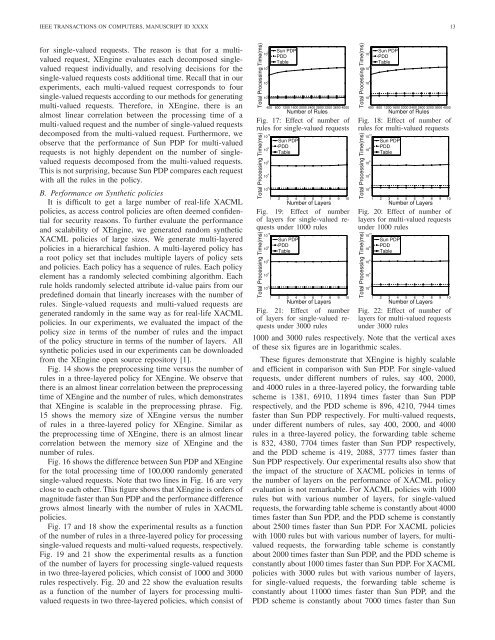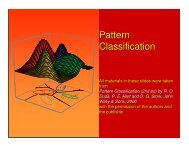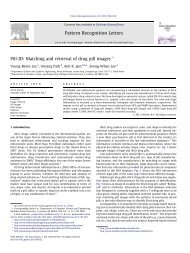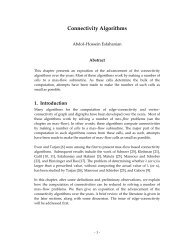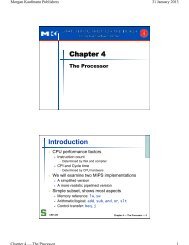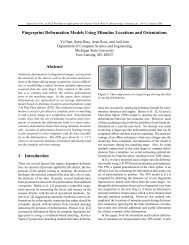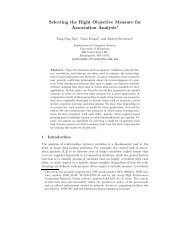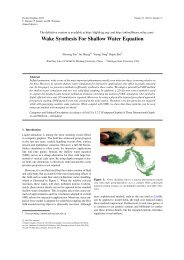Designing Fast and Scalable XACML Policy Evaluation Engines
Designing Fast and Scalable XACML Policy Evaluation Engines
Designing Fast and Scalable XACML Policy Evaluation Engines
Create successful ePaper yourself
Turn your PDF publications into a flip-book with our unique Google optimized e-Paper software.
IEEE TRANSACTIONS ON COMPUTERS, MANUSCRIPT ID XXXX 13for single-valued requests. The reason is that for a multivaluedrequest, XEngine evaluates each decomposed singlevaluedrequest individually, <strong>and</strong> resolving decisions for thesingle-valued requests costs additional time. Recall that in ourexperiments, each multi-valued request corresponds to foursingle-valued requests according to our methods for generatingmulti-valued requests. Therefore, in XEngine, there is analmost linear correlation between the processing time of amulti-valued request <strong>and</strong> the number of single-valued requestsdecomposed from the multi-valued request. Furthermore, weobserve that the performance of Sun PDP for multi-valuedrequests is not highly dependent on the number of singlevaluedrequests decomposed from the multi-valued requests.This is not surprising, because Sun PDP compares each requestwith all the rules in the policy.B. Performance on Synthetic policiesIt is difficult to get a large number of real-life <strong>XACML</strong>policies, as access control policies are often deemed confidentialfor security reasons. To further evaluate the performance<strong>and</strong> scalability of XEngine, we generated r<strong>and</strong>om synthetic<strong>XACML</strong> policies of large sizes. We generate multi-layeredpolicies in a hierarchical fashion. A multi-layered policy hasa root policy set that includes multiple layers of policy sets<strong>and</strong> policies. Each policy has a sequence of rules. Each policyelement has a r<strong>and</strong>omly selected combining algorithm. Eachrule holds r<strong>and</strong>omly selected attribute id-value pairs from ourpredefined domain that linearly increases with the number ofrules. Single-valued requests <strong>and</strong> multi-valued requests aregenerated r<strong>and</strong>omly in the same way as for real-life <strong>XACML</strong>policies. In our experiments, we evaluated the impact of thepolicy size in terms of the number of rules <strong>and</strong> the impactof the policy structure in terms of the number of layers. Allsynthetic policies used in our experiments can be downloadedfrom the XEngine open source repository [1].Fig. 14 shows the preprocessing time versus the number ofrules in a three-layered policy for XEngine. We observe thatthere is an almost linear correlation between the preprocessingtime of XEngine <strong>and</strong> the number of rules, which demonstratesthat XEngine is scalable in the preprocessing phrase. Fig.15 shows the memory size of XEngine versus the numberof rules in a three-layered policy for XEngine. Similar asthe preprocessing time of XEngine, there is an almost linearcorrelation between the memory size of XEngine <strong>and</strong> thenumber of rules.Fig. 16 shows the difference between Sun PDP <strong>and</strong> XEnginefor the total processing time of 100,000 r<strong>and</strong>omly generatedsingle-valued requests. Note that two lines in Fig. 16 are veryclose to each other. This figure shows that XEngine is orders ofmagnitude faster than Sun PDP <strong>and</strong> the performance differencegrows almost linearly with the number of rules in <strong>XACML</strong>policies.Fig. 17 <strong>and</strong> 18 show the experimental results as a functionof the number of rules in a three-layered policy for processingsingle-valued requests <strong>and</strong> multi-valued requests, respectively.Fig. 19 <strong>and</strong> 21 show the experimental results as a functionof the number of layers for processing single-valued requestsin two three-layered policies, which consist of 1000 <strong>and</strong> 3000rules respectively. Fig. 20 <strong>and</strong> 22 show the evaluation resultsas a function of the number of layers for processing multivaluedrequests in two three-layered policies, which consist ofTotal Processing Time(ms)Sun PDP10 8PDDTable10 610 410 2Number of Rules400 800 1200 1600 2000 2400 2800 3200 3600 4000Fig. 17: Effect of number ofrules for single-valued requestsTotal Processing Time(ms)10 10 Sun PDPPDD10 8Table10 610 410 2Number of Layers1 2 3 4 5 6 7 8 9 10Fig. 19: Effect of numberof layers for single-valued requestsunder 1000 rulesTotal Processing Time(ms)10 10 Sun PDPPDD10 8Table10 610 410 2Number of Layers1 2 3 4 5 6 7 8 9 10Fig. 21: Effect of numberof layers for single-valued requestsunder 3000 rulesTotal Processing Time(ms)Sun PDP10 8PDDTable10 610 410 2Number of Rules400 800 1200 1600 2000 2400 2800 3200 3600 4000Fig. 18: Effect of number ofrules for multi-valued requestsTotal Processing Time(ms)10 10 Sun PDPPDD10 8Table10 610 410 2Number of Layers1 2 3 4 5 6 7 8 9 10Fig. 20: Effect of number oflayers for multi-valued requestsunder 1000 rulesTotal Processing Time(ms)10 10 Sun PDPPDD10 8Table10 610 410 2Number of Layers1 2 3 4 5 6 7 8 9 10Fig. 22: Effect of number oflayers for multi-valued requestsunder 3000 rules1000 <strong>and</strong> 3000 rules respectively. Note that the vertical axesof these six figures are in logarithmic scales.These figures demonstrate that XEngine is highly scalable<strong>and</strong> efficient in comparison with Sun PDP. For single-valuedrequests, under different numbers of rules, say 400, 2000,<strong>and</strong> 4000 rules in a three-layered policy, the forwarding tablescheme is 1381, 6910, 11894 times faster than Sun PDPrespectively, <strong>and</strong> the PDD scheme is 896, 4210, 7944 timesfaster than Sun PDP respectively. For multi-valued requests,under different numbers of rules, say 400, 2000, <strong>and</strong> 4000rules in a three-layered policy, the forwarding table schemeis 832, 4380, 7704 times faster than Sun PDP respectively,<strong>and</strong> the PDD scheme is 419, 2088, 3777 times faster thanSun PDP respectively. Our experimental results also show thatthe impact of the structure of <strong>XACML</strong> policies in terms ofthe number of layers on the performance of <strong>XACML</strong> policyevaluation is not remarkable. For <strong>XACML</strong> policies with 1000rules but with various number of layers, for single-valuedrequests, the forwarding table scheme is constantly about 4000times faster than Sun PDP, <strong>and</strong> the PDD scheme is constantlyabout 2500 times faster than Sun PDP. For <strong>XACML</strong> policieswith 1000 rules but with various number of layers, for multivaluedrequests, the forwarding table scheme is constantlyabout 2000 times faster than Sun PDP, <strong>and</strong> the PDD scheme isconstantly about 1000 times faster than Sun PDP. For <strong>XACML</strong>policies with 3000 rules but with various number of layers,for single-valued requests, the forwarding table scheme isconstantly about 11000 times faster than Sun PDP, <strong>and</strong> thePDD scheme is constantly about 7000 times faster than Sun


